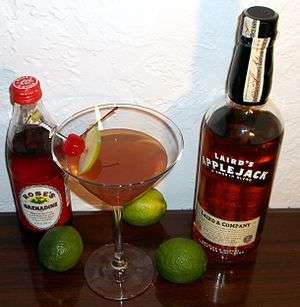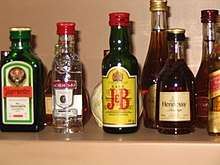Applejack (drink)



Applejack is a strong apple-flavored alcoholic drink produced from apples, popular in the American colonial era.[1][2][3] The name derives from "jacking", a term for "increasing" (alcohol content) and specifically for "freeze distilling", the traditional method of producing the drink.[1]
History
In colonial New Jersey, applejack was used as currency to pay road construction crews during the colonial period, leading to the slang name 'Jersey Lightning'.[4] The oldest licensed applejack distillery in the United States, Laird & Company of Scobeyville, New Jersey, was until recently the country's only remaining producer of applejack.[4]
Because freeze distillation is a low-infrastructure method of production compared to evaporative distillation, and doesn't, for example, require burning firewood to create heat,[3] hard cider and applejack were historically easy to produce,[3] though more expensive than grain alcohol,[5] and hence were important drinks in the colonial era and the early years of the United States, particularly in cold northern areas without access to clean water.
Production
Applejack was historically made by concentrating cider through the traditional method of freeze distillation: The alcoholic fruit beer produced after the fall harvest was left outside during the winter. Periodically the frozen chunks of ice which had formed were removed, thus concentrating the unfrozen alcohol in the remaining liquid.[3] Starting with the fermented juice, with an alcohol content of less than ten percent, the concentrated result can contain 25–40% alcohol.[3]
When commercial production began, applejack was also starting to be produced through evaporative distillation.[6] Modern commercially produced applejack is often no longer produced by jacking but rather by blending apple brandy and neutral spirits.[2][3][7] However, the American Alcohollery in Moravian Falls, North Carolina, makes a traditionally produced applejack called Applejohn.
Decline in popularity
With easy availability of grain, metal stills, clean water, and eventually pasteurization starting in the mid-19th century, cider and applejack were gradually displaced by other drinks and liquors. Apple alcohols were less economical to produce than grain alcohol.[5] In the late 19th and early 20th centuries, traditional applejack also acquired a stigma as a result of its association with the older production process.
Health concerns also arose from a lack of education. Freeze distillation concentrates not only the drinkable ethanol but also the methanol and fusel alcohols (byproducts of fermentation which distillation by heat separates out); these latter can be unhealthy.[8] The high methanol and fusel alcohols started with poor fermentation practices. Reducing methanol with the absorption of 4A molecular sieve is a practical method for production.[9]
See also
- Calvados (brandy), a similar French drink
- Cider
- Fractional freezing
- Ice beer
References
- 1 2 Black, Rachel (2010). Alcohol in Popular Culture: An Encyclopedia. Santa Barbara, CA: AB-CLIO, LLC. p. 10. ISBN 978-0-313-38048-8. Retrieved 2011-10-22.
- 1 2 Michael Foley, Drinking with the Saints: The Sinner's Guide to a Holy Happy Hour (2015, ISBN 1621573834): Perhaps the most interesting option is applejack, the first distilled liquor native to North America and a great favorite among the colonists. [Now] usually a blend of apple brandy and neutral spirits that retains the flavor of the apples[.]
- 1 2 3 4 5 6 Sanborn Conner Brown, Wines & Beers of Old New England: A How-to-do-it History (1978, ISBN 0874511488)
- 1 2 Karen Tina Harrison, Jersey Lightning, New Jersey Monthly, July 13, 2009.
- 1 2 Lew Nichols, Annie Proulx, Cider: Making, Using & Enjoying Sweet & Hard Cider, 3rd Edition (2015, ISBN 1603428399)
- ↑ Scott C. Martin, The SAGE Encyclopedia of Alcohol (2015, ISBN 1483331083): The evaporative technique was used when commercial applejack production began.
- ↑ "2005-Laird apple products sell sheet" (PDF). Laird & Company. Archived from the original (PDF) on 26 January 2007. Retrieved 17 January 2014.
- ↑ Ben Watson, Cider, Hard and Sweet: History, Traditions, and Making Your Own, Third Edition
- ↑ "Archived copy". Archived from the original on 2013-05-17. Retrieved 2013-01-28.



